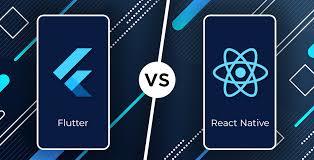Why I Believe Flutter Is the Future of Cross-platform App Devel
-
Welcome to the exciting world of cross-platform app development! In today's digital age, building apps that work seamlessly across multiple platforms is not just a trend but a necessity. And when it comes to choosing the right framework for this task, Flutter stands head and shoulders above the rest.
Are you ready to dive into the future of app development? In this blog post, we will explore why I firmly believe that Flutter is the ultimate game-changer in cross-platform app development. From its undeniable advantages over other frameworks like React Native to how you can get started with Flutter yourself – we've got all your burning questions covered. So fasten your seatbelts and get ready for an exhilarating journey through the endless possibilities of Flutter!
The Advantages of Flutter

One of the biggest advantages of Flutter is its ability to deliver a truly native experience across multiple platforms. With Flutter, you can create apps for iOS and Android that not only look stunning but also perform flawlessly. Whether it's smooth animations or responsive UIs, Flutter has got you covered.
Another key advantage is the hot reload feature, which allows developers to see their changes instantly without having to restart the app. This significantly speeds up the development process and makes debugging a breeze. No more wasting time on lengthy compile times!
Flutter also boasts an extensive set of customizable widgets that are ready-made for building beautiful user interfaces. From buttons and sliders to complex layouts, these widgets make designing your app a breeze. And with Flutter's rich ecosystem of packages and plugins, you have access to an ever-growing library of tools and functionalities.
Furthermore, Flutter offers excellent performance thanks to its Dart programming language. Dart employs a Just-in-Time (JIT) compilation during development and Ahead-of-Time (AOT) compilation for production builds – resulting in fast startup times and efficient execution.
One cannot overlook the robust community support behind Flutter. Developers from around the world actively contribute to its growth by sharing resources, tutorials, and libraries – making it easier than ever to learn and master this powerful framework.
Intrigued? Let's now compare Flutter with another popular framework: React Native!
Flutter vs React Native: A Battle of the Cross-Platform Titans

When it comes to cross-platform app development, two frameworks have emerged as frontrunners - Flutter and React Native. Both are powerful tools that allow developers to create stunning mobile applications with a single codebase. But which one should you choose? Let's take a closer look.
One key advantage of Flutter is its performance. Powered by Dart, an efficient programming language, Flutter apps boast fast start-up times and smooth animations that rival even native apps. This ensures a seamless user experience across different devices.
React Native, on the other hand, leverages JavaScript to build mobile apps. It has gained popularity due to its large community support and extensive library of ready-to-use components. However, compared to Flutter, React Native can sometimes suffer from performance issues.
Another area where these frameworks differ is in their UI capabilities. With Flutter's "widget" system, developers can easily create beautiful custom-designed interfaces that adhere to Material Design or Cupertino style guidelines for Android and iOS respectively.
React Native takes a different approach by using native components for rendering UI elements on both platforms. While this allows for more platform-specific customization options, it can be challenging when trying to achieve pixel-perfect designs across multiple devices.
Moreover, when it comes to testing and debugging your app, both frameworks offer excellent tools. However, Flutter's built-in tooling stands out with features like hot reload which allows real-time updates without losing the app state during development.
In terms of community support and third-party libraries availability, React Native has been around longer than Flutter and thus enjoys a larger ecosystem at present. However, due to its growing popularity among developers worldwide, QSS Technosoft Inc offers flutter app development services if you're looking for experienced talent in building high-quality cross-platform apps using the latest technologies including flutter
Ultimately, the choice between Flutter and React Native depends on your specific project requirements.
How to Get Started with Flutter
If you're ready to dive into the world of cross-platform app development with Flutter, here's a step-by-step guide to help you get started.
First and foremost, make sure you have the latest version of Flutter installed on your system. You can download it from the official website and follow the installation instructions provided.
Once Flutter is set up, it's time to choose your favorite code editor or IDE (Integrated Development Environment). Popular options include Visual Studio Code, Android Studio, and IntelliJ IDEA. Pick one that suits your preferences and familiarity.
Next, create a new project in your chosen code editor/IDE using the flutter create command. This will generate a basic project structure for you to work with.
Now comes the fun part - writing code! Start by exploring the main.dart file in your project folder. This is where you'll write most of your app logic and UI components using Dart programming language.
Flutter provides an extensive set of widgets that allow you to build beautiful user interfaces effortlessly. Take advantage of these widgets as building blocks for creating stunning designs.
As you develop your app, don't forget to test it along the way. The Flutter framework includes tools like hot reload which allow for quick iterations and instant feedback on changes made in real-time.
To deploy your app on various platforms such as iOS and Android devices, use flutter run command followed by specific flags based on where you want to run/debug/test your application.
Remember that learning any new technology takes time and practice. Utilize online resources like documentation, tutorials, forums or even join developer communities where experts share tips & tricks related specifically about the Flutter development process
Conclusion
Flutter is undoubtedly the future of cross-platform app development. With its numerous advantages, such as fast development, hot reload feature, beautiful UI designs, and extensive community support, it has become a top choice for developers worldwide.
When compared to React Native, Flutter stands out with its superior performance and seamless user experience. While React Native has its own merits and remains a popular choice among developers, Flutter offers a more efficient approach to building high-quality apps that work flawlessly on both Android and iOS platforms.
If you're looking to get started with Flutter development or hire skilled Flutter developers for your project needs, QSS Technosoft Inc. should be at the top of your list. They have a team of experienced professionals who are well-versed in developing robust and visually appealing cross-platform applications using Flutter.
So why wait? Embrace the future of cross-platform app development by choosing Flutter today! Experience the power and flexibility it offers while delivering stunning apps that meet your business objectives efficiently.
Remember – when you opt for Flutter development from QSS Technosoft Inc., you're not just hiring Flutter developers – you're investing in quality craftsmanship that will take your app to new heights!
Get ahead in this competitive digital landscape by making the smart choice - join the revolution with Flutter!

